In the rapidly advancing world of home entertainment, having the best Home Theater Systems has become essential for creating an immersive movie-watching experience.
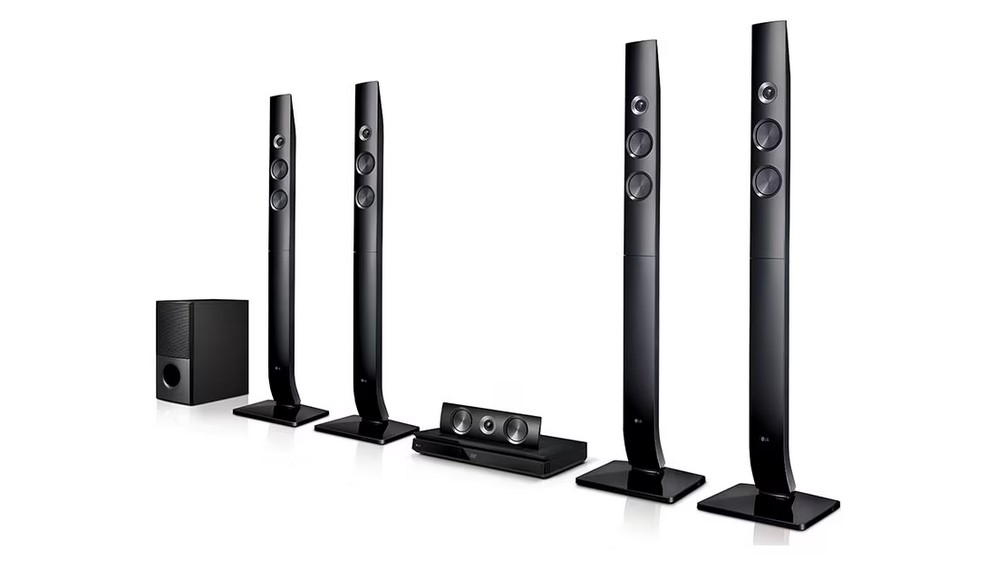
Home Theater Systems are not just about sound and visuals; they are about transforming your living space into a private cinema where you can enjoy your favorite films with the highest quality possible.
Whether you’re a casual movie watcher or a dedicated cinephile, the right Home Theater System can make all the difference in how you experience movies at home.
Verdict on Home Theater Systems
When it comes to creating the perfect movie experience at home, Home Theater Systems are indispensable.
In 2025, the range of options available to consumers is vast, with systems catering to every level of enthusiast.
Whether you prioritize sound quality, visual clarity, or ease of use, the right Home Theater System will elevate your viewing experience to new heights.
Investing in a high-quality system not only enhances your entertainment but also adds value to your home setup.
As technology advances, these systems are becoming more user-friendly, feature-rich, and accessible, making now the perfect time to upgrade.
What is a Home Theater System?
A Home Theater System is an integrated audio-visual setup designed to replicate the cinema experience in the comfort of your home.
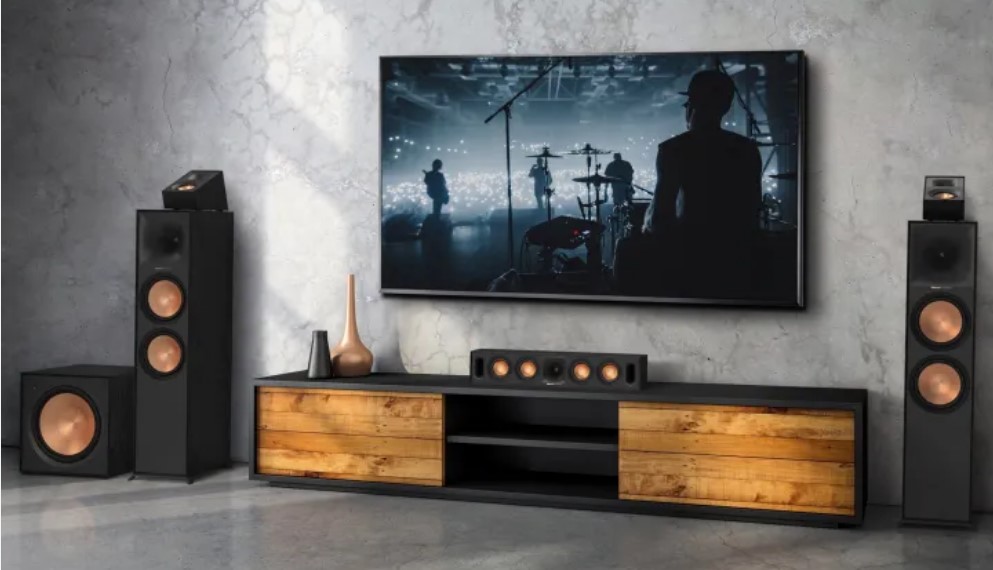
It typically includes a combination of a television or projector, surround sound speakers, a subwoofer, and a media player or receiver.
| Home Theater System | Best Features | User Experience and Reviews |
|---|---|---|
| Sony HT-A7000 | – Dolby Atmos support – Built-in subwoofer – Wireless rear speakers – 4K HDR compatibility – Voice control | Users praise the immersive sound and easy setup, though some mention the premium price tag. |
| Bose Lifestyle 650 | – True 5.1-channel surround sound – Wireless connectivity – AdaptiQ technology – 4K pass-through – Universal remote | Highly rated for exceptional sound quality and sleek design, but setup can be complex and the price is high. |
| LG SP11RA | – Dolby Atmos and DTS:X support – High-resolution audio – Wireless subwoofer – AI room calibration – HDMI eARC | Appreciated for its powerful sound, particularly in larger rooms, but the system’s size may not suit smaller spaces. |
| Samsung HW-Q990B | – True 11.1.4 surround sound – SpaceFit Sound+ – Dolby Atmos & DTS:X – Wireless rear speakers – SmartThings compatibility | Widely praised for audio depth and immersive experience, though extensive features may be overkill for smaller spaces. |
| Sonos Arc | – Dolby Atmos support – Voice control (Alexa, Google Assistant) – Trueplay tuning – Multi-room audio – HDMI eARC | Highly rated for audio quality and ease of use, especially with smart home integration, but the price is on the higher side. |
These systems can range from simple soundbar setups to elaborate configurations with multiple speakers, amplifiers, and advanced digital processing features.
The goal of a Home Theater System is to provide an immersive experience, making you feel as though you’re right in the middle of the action.
Why Should You Consider Home Theater Systems?
Considering a Home Theater System comes with several benefits that can significantly enhance your home entertainment experience:
- Immersive Audio Experience: Surround sound systems provide a 360-degree audio experience that makes movies more engaging.
- Superior Visual Quality: High-definition and 4K projectors or TVs ensure that you get the best visual clarity.
- Convenience: Bringing the theater experience home allows you to enjoy movies at your own pace, without leaving your home.
- Customization: Many Home Theater Systems offer customization options to suit your room size and personal preferences.
- Increased Home Value: A well-installed Home Theater System can increase the value of your home.
Best Features for Home Theater Systems in 2024
When choosing a Home Theater System in 2025, look for the following features:
- Dolby Atmos Support: Enhances audio experience with 3D soundscapes.
- 4K Ultra HD Resolution: Delivers stunning visual clarity and detail.
- Wireless Connectivity: Simplifies setup and integration with other smart home devices.
- Voice Control Compatibility: Allows hands-free operation using voice commands.
- Energy Efficiency: Systems designed to consume less power while delivering top performance.
Best Features for Home Theater Systems in 2025
When choosing a Home Theater System in 2025, look for the following features:
1. Sony HT-A7000
Best For: Comprehensive audio and visual experience in home theater systems.
Best Features: Dolby Atmos support, integrated subwoofer, and wireless connectivity.
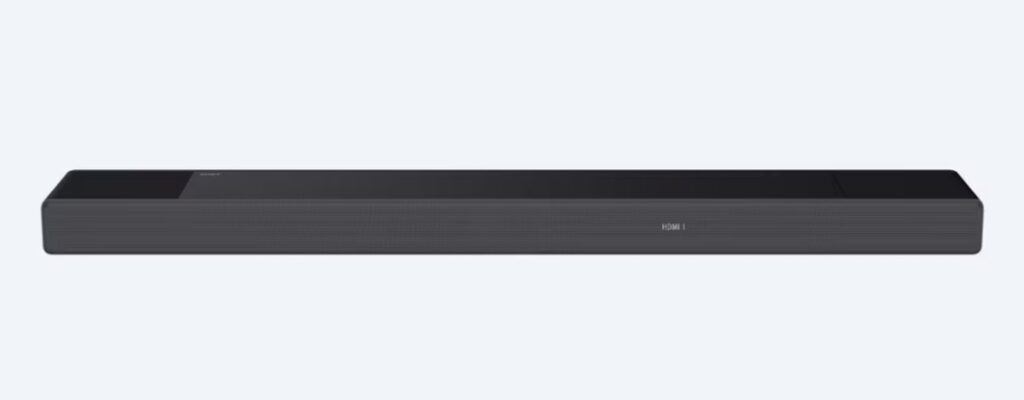
Product Descriptions: The Sony HT-A7000 is a premium soundbar designed for movie enthusiasts who want the best in both sound and visual synchronization.
This home theater system features a built-in subwoofer, wireless rear speakers, and Dolby Atmos support, providing an immersive 3D sound experience.
It’s a versatile option for those looking to enhance their movie-watching experience without the clutter of multiple components.
Ryan’s Advice: Ideal for those who desire a high-quality sound system without the complexity of multiple setups.
Best Features for Sony HT-A7000:
- Dolby Atmos Support: Creates an immersive audio experience.
- Built-in Subwoofer: Delivers deep bass without needing extra components.
- Wireless Rear Speakers: Offers flexible placement within your home theater system.
- 4K HDR Compatibility: Ensures superior visual quality for movies.
- Voice Control: Compatible with popular voice assistants like Alexa and Google Assistant.
User Experiences and Case Studies: Users have praised the Sony HT-A7000 for its rich, immersive sound and easy setup, though some have noted that it comes with a premium price tag.
The system has been particularly popular among those looking for a high-end soundbar that delivers on all fronts.
Price Range:
- Basic Setup: $1,200
- Full Setup: $1,800
2. Bose Lifestyle 650
Best For: High-end home theater systems with sleek design and powerful sound.
Best Features: True 5.1-channel surround sound, AdaptiQ technology, and wireless connectivity.
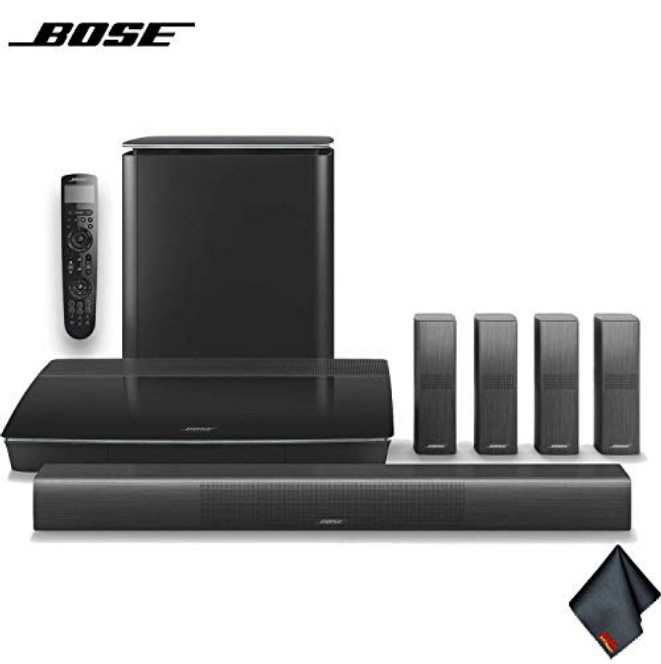
Product Descriptions: The Bose Lifestyle 650 is a luxury home theater system that combines powerful performance with elegant design.
It delivers true 5.1-channel surround sound, making it perfect for immersive movie experiences.
With wireless connectivity and Bose’s AdaptiQ technology, this system customizes the sound to your room’s acoustics for optimal performance.
Ryan’s Advice: Perfect for those who want a visually appealing and powerful home theater system.
Best Features for Bose Lifestyle 650:
- Surround Sound: Provides an authentic 5.1-channel audio experience.
- Wireless Connectivity: Simplifies the setup process and keeps your space clutter-free.
- AdaptiQ Technology: Automatically adjusts sound settings to fit your room.
- 4K Pass-Through: Ensures compatibility with the latest video formats.
- Universal Remote: Manages all your entertainment devices with ease.
User Experiences and Case Studies: The Bose Lifestyle 650 is highly rated for its exceptional sound quality and sleek design.
However, some users have found the setup process to be somewhat complex, requiring careful attention to detail to achieve the best results.
Price Range:
- Standard: $3,999
- With Accessories: $4,299
3. LG SP11RA
Best For: Audiophiles looking for advanced surround sound in home theater systems.
Best Features: Dolby Atmos and DTSsupport, high-resolution audio, and AI room calibration.
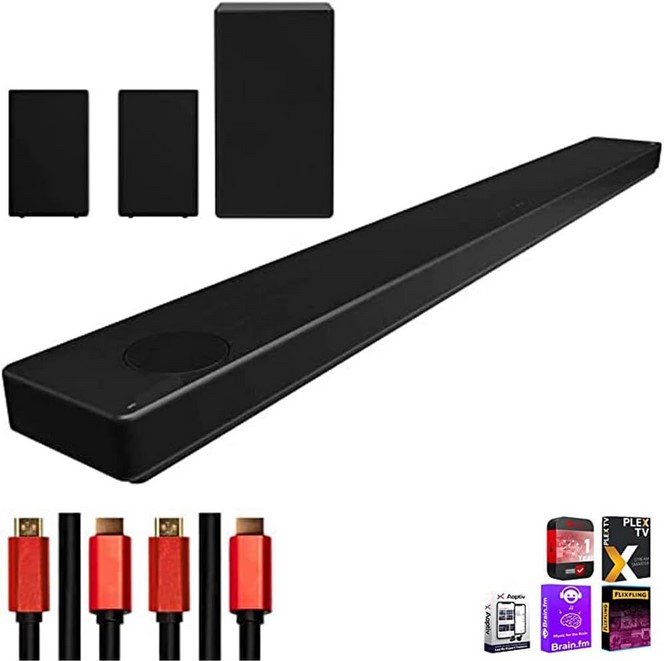
Product Descriptions: The LG SP11RA is a high-performance soundbar system that caters to those who prioritize sound quality. It supports both Dolby Atmos and DTS, offering a powerful and dynamic audio experience.
The system also features a wireless subwoofer and AI room calibration, ensuring that the sound adapts perfectly to your space.
Ryan’s Advice: Ideal for serious movie lovers and audiophiles who demand superior sound quality in their home theater systems.
Best Features for LG SP11RA:
- Dolby Atmos and DTS: Provides advanced 3D soundscapes.
- High-Resolution Audio: Delivers clear and detailed sound.
- Wireless Subwoofer: Offers flexibility in speaker placement.
- AI Room Calibration: Customizes audio output to your room’s layout.
- HDMI eARC: Supports high-quality audio formats for a richer experience.
User Experiences and Case Studies: The LG SP11RA is appreciated for its powerful sound output, particularly in larger rooms where the full effects of Dolby Atmos can be enjoyed.
Some users, however, have noted that the system’s large size might not suit smaller spaces.
Price Range:
- Base Model: $1,499
- Full System: $1,799
4. Samsung HW-Q990B
Best For: Versatile and powerful audio performance in home theater systems.
Best Features: True 11.1.4 surround sound, SpaceFit Sound+, and SmartThings compatibility.
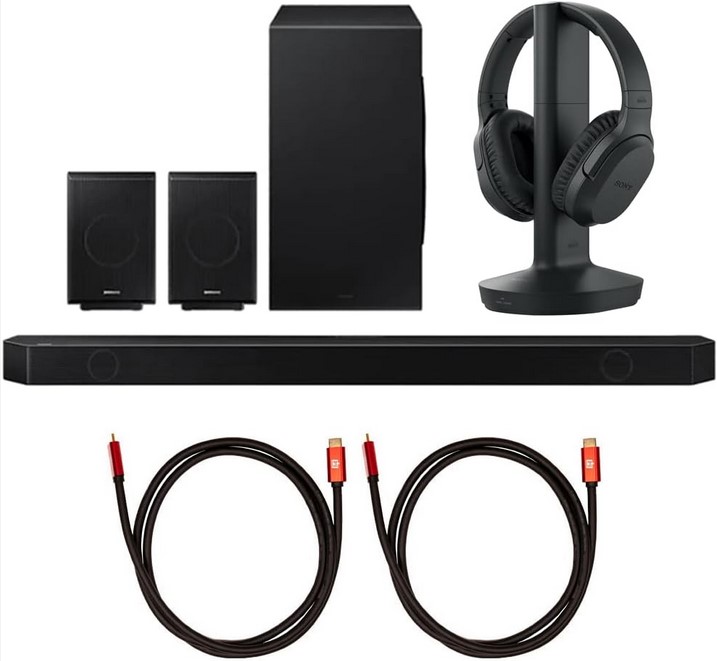
Product Descriptions: Samsung’s HW-Q990B is a state-of-the-art soundbar system that provides true 11.1.4 surround sound, making it one of the most comprehensive home theater systems available.
It’s designed to fill large rooms with sound, using SpaceFit Sound+ to automatically optimize the audio based on your room’s acoustics. The system also integrates seamlessly with Samsung’s SmartThings ecosystem.
Ryan’s Advice: Ideal for users with large living spaces who need robust sound coverage.
Best Features for Samsung HW-Q990B:
- True 11.1.4 Sound: Offers full surround sound experience with multiple speakers.
- SpaceFit Sound+: Automatically adjusts audio settings for optimal sound.
- Dolby Atmos & DTS: Creates immersive 3D audio environments.
- Wireless Rear Speakers: Provides flexibility in speaker placement.
- SmartThings Compatibility: Easily integrates with Samsung’s smart home devices.
User Experiences and Case Studies: The Samsung HW-Q990B is widely praised for its audio depth and the immersive experience it provides. Some users, however, feel that its extensive features and setup might be overkill for smaller spaces.
Price Range:
- Basic Setup: $1,899
- With Additional Speakers: $2,299
5. Sonos Arc
Best For: High-quality soundbar with smart features in home theater systems.
Best Features: Dolby Atmos support, multi-room audio, and voice control.
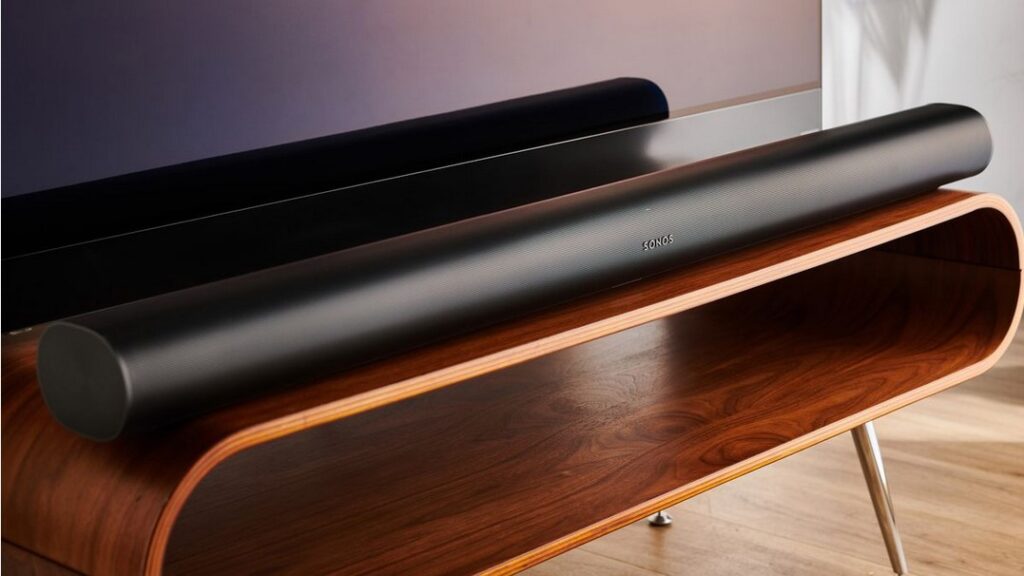
Product Descriptions: The Sonos Arc is a sleek, premium soundbar that provides a rich, immersive sound experience for home theater systems. It’s designed with smart features, including voice control and multi-room audio capabilities, making it a versatile addition to any home.
The Arc is particularly known for its seamless integration with other Sonos speakers, allowing you to build out your home theater setup as needed.
Ryan’s Advice: Ideal for users looking for a minimalist yet powerful home theater system with smart home integration.
Best Features for Sonos Arc:
- Dolby Atmos Support: Delivers immersive sound with 3D effects.
- Voice Control: Built-in Alexa and Google Assistant for easy control.
- Trueplay Tuning: Automatically adapts sound to your room.
- Multi-Room Audio: Syncs with other Sonos speakers for whole-home sound.
- HDMI eARC: Supports enhanced audio return channel for better sound quality.
User Experiences and Case Studies: The Sonos Arc is highly rated for its audio quality and ease of use, especially in homes where smart features are a priority.
While it’s priced higher than some alternatives, users often find that its performance and integration capabilities justify the cost.
Price Range:
- Single Soundbar: $899
- Full Setup: $1,199
Home Theater Systems
Budget-Friendly Home Theater Systems:
- Sony HT-S350: Ideal for those who want a simple, affordable soundbar system. It offers decent sound quality without breaking the bank.
- Vizio V-Series 5.1: A complete surround sound system that’s affordable and delivers a surprisingly robust audio experience for its price.
2. Premium Home Theater Systems:
- Bose Lifestyle 650: For those seeking the ultimate in luxury and performance, this system delivers unparalleled sound quality and sleek aesthetics.
- Samsung HW-Q990B: Offers a true 11.1.4 surround sound experience with Dolby Atmos, perfect for large rooms and high-end setups.
3. Home Theater Systems for Small Spaces:
- Sonos Beam (Gen 2): Compact but powerful, this soundbar is ideal for apartments or smaller rooms where space is at a premium.
- Yamaha YAS-209: Another compact soundbar that delivers clear sound and comes with a built-in Alexa, making it perfect for small spaces.
4. Home Theater Systems for Large Rooms:
- LG SP11RA: This system’s powerful audio output and Dolby Atmos support make it ideal for filling large spaces with immersive sound.
- Sony HT-A7000: Equipped with a powerful soundbar and wireless subwoofer, it’s perfect for large living rooms or home theater setups.
5. Systems Best Suited for Gaming:
- Razer Leviathan: Specifically designed with gamers in mind, this soundbar delivers rich audio with deep bass, perfect for enhancing gaming experiences.
- Sony HT-G700: A soundbar system that supports Dolby Atmos, providing an immersive experience for gaming and movies alike.
6. Systems Best Suited for Movie Watching:
- Sonos Arc: With its Dolby Atmos support and multi-room audio capabilities, the Sonos Arc is perfect for movie enthusiasts who want top-tier sound quality.
- LG SN11RG: A premium soundbar system with rear speakers and subwoofer, ideal for creating a cinema-like experience at home.
Setting Up Your Home Theater System
Setting up Home Theater Systems can seem daunting, but with the right guidance, you can create an immersive entertainment experience in your home.
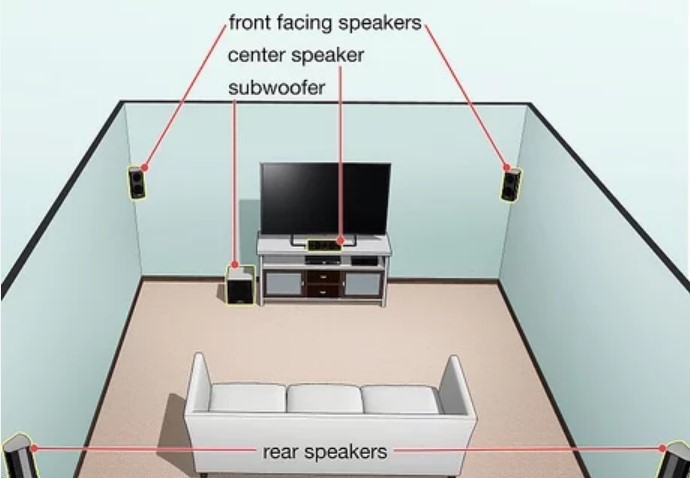
Here’s a step-by-step guide to help you set up your system, along with tips on speaker placement and common mistakes to avoid.
1. Step-by-Step Guide to Setting Up a Home Theater System:
- Step 1: Choose the right location. Identify the best room or area in your home where the system will be set up. Consider factors like room size, acoustics, and lighting.
- Step 2: Unbox and position your components. Start by placing the television or projector in the optimal viewing spot, usually centered on the main wall. Arrange the speakers around the room, ensuring they are positioned at ear level when seated.
- Step 3: Connect your components. Use HDMI cables to connect your TV/projector to the receiver or soundbar. Connect the speakers to the receiver, ensuring the correct channels are matched (left, right, center, etc.).
- Step 4: Calibrate the audio. Most modern receivers have auto-calibration features. Use a microphone to measure sound levels and automatically adjust settings for the best sound quality.
- Step 5: Test your system. Play a movie or music to test the sound and picture quality. Adjust settings as needed to ensure the best experience.
Tips on Speaker Placement for Optimal Sound:
- Center Speaker: Place directly above or below the TV for clear dialogue.
- Front Left and Right Speakers: Position at an equal distance from the center speaker, angled slightly towards the listener.
- Surround Speakers: Place to the sides or slightly behind the listening area, at ear level.
- Subwoofer: Place near a wall or corner to enhance bass output without distortion.
Common Setup Mistakes and How to Avoid Them:
- Mistake 1: Placing speakers at different heights. This can lead to uneven sound distribution. Always position speakers at ear level when seated.
- Mistake 2: Ignoring room acoustics. Hard surfaces reflect sound, while soft furnishings absorb it. Balance your room to avoid echo or muffled sound.
- Mistake 3: Not using the correct cables. Ensure you’re using high-quality HDMI cables for the best audio and video output.
Comparison of Top Brands
When selecting Home Theater Systems, it’s essential to compare the top brands to find one that best suits your needs.
Here’s a detailed comparison of some of the most popular brands in the market.
1. Sony:
- Pros: Sony systems are known for their balance between audio and visual quality, with a wide range of products suitable for different budgets.
- Cons: Some users find Sony systems slightly more expensive compared to competitors offering similar features.
2. Bose:
- Pros: Bose is synonymous with high-end audio quality and sleek design. Their systems are often praised for their superior sound performance and aesthetics.
- Cons: Bose systems tend to be on the higher end of the price spectrum, which might not suit budget-conscious consumers.
3. Samsung:
- Pros: Samsung offers a broad range of Home Theater Systems, from budget-friendly options to high-end systems with advanced features like Dolby Atmos.
- Cons: While Samsung’s systems are feature-rich, some users report that their audio quality, particularly in mid-range products, can sometimes lag behind competitors.
4. LG:
- Pros: LG is known for offering great value for money, with systems that combine solid audio performance with innovative features like AI room calibration.
- Cons: LG’s speaker designs are often bulkier, which may not appeal to those looking for more discreet systems.
5. Sonos:
- Pros: Sonos systems are renowned for their multi-room audio capabilities and seamless integration with smart home devices.
- Cons: The cost of building a full Sonos home theater system can be high, especially when adding additional speakers.
Home Theater System Accessories
To get the most out of your Home Theater Systems, it’s important to consider essential accessories that can enhance your overall experience.
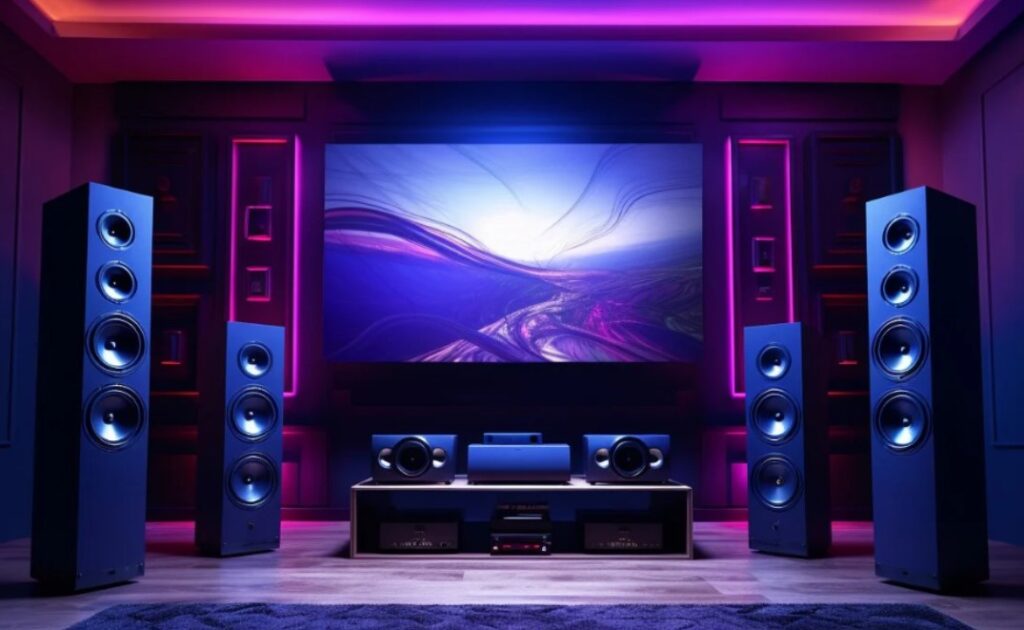
1. Universal Remotes:
- Overview: A universal remote allows you to control all your devices—TV, receiver, Blu-ray player, and more—from a single remote. Popular options include the Logitech Harmony series, which can be programmed to control multiple devices with ease.
- Enhancement: Simplifies operation and reduces clutter by eliminating the need for multiple remotes.
2. Speaker Stands:
- Overview: Proper speaker placement is crucial for achieving the best sound quality. Speaker stands help position your speakers at the ideal height and angle, especially for surround and rear speakers.
- Enhancement: Ensures optimal sound distribution and prevents sound distortion due to improper placement.
3. Cables and Cable Management:
- Overview: High-quality HDMI cables are essential for delivering the best audio and video quality. Additionally, cable management systems keep your setup neat and organized, preventing tangling and interference.
- Enhancement: Enhances the performance of your Home Theater Systems by ensuring clean, uninterrupted signals and maintaining a tidy setup.
4. Surge Protectors:
- Overview: Protect your investment with a good surge protector, which safeguards your Home Theater Systems from power surges and electrical spikes.
- Enhancement: Provides peace of mind by protecting your expensive equipment from potential damage.
5. Wall Mounts and Brackets:
- Overview: Mounting your TV or speakers on the wall not only saves space but also improves viewing angles and sound distribution.
- Enhancement: Creates a more immersive and cinematic experience by optimizing the layout of your Home Theater Systems.
Maintenance and Troubleshooting Tips
Maintaining your Home Theater Systems is key to ensuring they deliver top performance for years to come.

Here are some tips on how to keep your system in great shape and troubleshoot common issues.
1. How to Maintain Your Home Theater System for Longevity:
- Regular Cleaning: Dust and dirt can accumulate on your components, affecting performance. Use a microfiber cloth to clean your TV screen, speakers, and other components regularly.
- Ventilation: Ensure your system components are well-ventilated to prevent overheating. Avoid placing them in enclosed spaces where heat can build up.
- Firmware Updates: Keep your system’s firmware up to date to benefit from the latest features and improvements.
2. Common Issues Users Face and How to Troubleshoot Them:
- No Sound from Speakers: Check if all cables are properly connected and that the correct input source is selected on your receiver or soundbar. If wireless, ensure the speakers are paired correctly.
- Picture Not Displaying: Ensure the HDMI cable is securely connected and the correct HDMI input is selected on your TV. Try using a different HDMI cable to rule out cable issues.
- Subwoofer Not Working: If your subwoofer isn’t producing sound, check the connection and ensure it’s paired with the receiver. If it’s a wired subwoofer, try connecting it to a different output on the receiver.
3. How to Extend the Lifespan of Your Home Theater System:
- Avoid Maximum Volume: Constantly running your system at maximum volume can strain the speakers and reduce their lifespan. Use moderate volume levels to prolong their life.
- Power Down When Not in Use: Turning off your system when not in use can save energy and reduce wear on the components.
- Regular Maintenance Checks: Periodically check all connections, update firmware, and clean your system to prevent issues from arising.
Future Trends in Home Theater Systems
The world of Home Theater Systems is always evolving, with new technologies emerging to enhance the viewing experience.

Here are some trends to watch in the coming years.
1. AI Integration:
- Overview: Artificial intelligence is set to play a bigger role in home theater systems. AI can optimize audio settings in real-time based on the content being played, or even adjust picture settings based on ambient lighting conditions.
- Impact: Makes systems more intuitive and user-friendly, allowing for a more personalized experience.
2. Voice Control:
- Overview: Voice assistants like Alexa, Google Assistant, and Siri are increasingly being integrated into home theater systems, allowing users to control their systems hands-free.
- Impact: Adds convenience and enhances accessibility, particularly for those who prefer a smart home setup.
3. 8K Compatibility:
- Overview: As 8K TVs become more popular, Home Theater Systems will also need to support 8K resolution to deliver the best possible picture quality.
- Impact: Provides ultra-high-definition viewing experiences, making movies and games more immersive than ever before.
4. Wireless Everything:
- Overview: The trend towards wireless technology will continue, with more systems offering wireless speakers, subwoofers, and even wireless power.
- Impact: Simplifies setup and reduces clutter, making home theater systems more accessible to the average consumer.
5. Enhanced Streaming Capabilities:
- Overview: With the rise of streaming services, home theater systems are being designed to integrate more seamlessly with platforms like Netflix, Amazon Prime, and Disney+.
- Impact: Provides easier access to content and improves the overall user experience by eliminating the need for multiple devices.
Buying Guide
Purchasing the right Home Theater Systems requires careful consideration.

Here’s a guide to help you make the best decision.
1. What to Consider When Purchasing a Home Theater System:
- Room Size: The size of your room will dictate the type and number of speakers you need. Larger rooms may require a more powerful system with additional speakers for full coverage.
- Budget: Determine your budget before shopping. There are great options available at various price points, but it’s important to find a balance between cost and quality.
- Primary Use: Consider how you will primarily use the system. If you’re a movie enthusiast, look for systems with Dolby Atmos and 4K support. Gamers might prioritize systems with low latency and high-quality audio.
- Compatibility: Ensure the system you choose is compatible with your existing devices, including your TV, streaming services, and smart home setup.
2. How to Balance Cost vs. Performance:
- Mid-Range Systems: Often, mid-range systems offer the best balance between cost and performance. Systems like the LG SP11RA or Sony HT-A7000 deliver excellent audio and visual quality without the premium price tag.
- Long-Term Investment: Consider a home theater system as a long-term investment. Spending a little more upfront for a higher-quality system can save you money in the long run, as you’re less likely to need upgrades or replacements.
3. Recommendations for Different Budgets:
- Under $500: Vizio V-Series 5.1 – Offers excellent value with full surround sound on a budget.
- $500 – $1,000: Sonos Beam (Gen 2) – A compact yet powerful soundbar ideal for small to medium-sized rooms.
- $1,000 – $2,000: Sony HT-A7000 – A versatile system that balances high-quality audio and video performance.
- $2,000+: Bose Lifestyle 650 – For those who want the best in sound and design, this system is worth the investment.
Verdict on Home Theater Systems
When it comes to choosing the right Home Theater Systems, the decision ultimately depends on your specific needs and preferences.
Whether you’re looking for a budget-friendly option, a premium setup, or something that suits a particular space or use case, there’s a home theater system out there that’s perfect for you.
Investing in a quality system can significantly enhance your home entertainment experience, providing years of enjoyment and making every movie night special.
Take the time to consider the features that matter most to you, and choose a system that aligns with your vision for the perfect home theater.
Where to Buy Home Theater Systems
Finding the best deals on Home Theater Systems can be just as important as choosing the right system.
Here are some tips on where to buy and what to look for.
1. Online Retailers:
- Amazon: Offers a wide selection of home theater systems, often with competitive pricing and customer reviews to help guide your decision.
- Best Buy: Provides detailed product information and customer reviews, along with the option for in-store pickup.
- B&H Photo Video: Known for carrying high-end home theater systems, with expert advice available online or via phone.
2. Brick-and-Mortar Stores:
- Best Buy: In addition to online shopping, Best Buy offers the advantage of seeing and hearing systems in person before purchasing.
- Costco: Often has exclusive bundles and deals on home theater systems, especially for members.
- Local Electronics Stores: Smaller, local stores may offer personalized service and expert advice, as well as the chance to support local businesses.
3. Tips for Purchasing Online:
- Check Reviews: Always read customer reviews to get an idea of the product’s performance and any potential issues.
- Look for Deals: Keep an eye out for sales events like Black Friday, Cyber Monday, or seasonal promotions, which can offer significant savings.
- Consider Warranty and Return Policy: Ensure the retailer offers a good return policy and warranty, especially when purchasing expensive systems.
FAQs About Home Theater Systems
Potential buyers often have questions about Home Theater Systems.
Here are some of the most common queries and their answers.
1. What are Home Theater Systems?
- Answer: Home theater systems are a combination of audio and visual components designed to replicate a cinema experience at home. They typically include a television or projector, surround sound speakers, and a receiver or soundbar.
2. How do I choose the right Home Theater System?
- Answer: Consider factors such as room size, budget, and your primary use (movies, gaming, music). Look for systems that offer the features you value most, like Dolby Atmos support, 4K compatibility, or wireless speakers.
3. Are Home Theater Systems compatible with streaming services?
- Answer: Yes, most modern home theater systems are compatible with popular streaming services. Some systems even have built-in apps for Netflix, Amazon Prime, and more, allowing you to stream content directly.
4. Can I upgrade my existing Home Theater System?
- Answer: Yes, you can upgrade components of your home theater system over time. For example, you can add a subwoofer, upgrade your speakers, or integrate a new receiver to improve audio and visual quality.
5. How energy-efficient are Home Theater Systems?
- Answer: Energy efficiency varies by system. Look for systems with energy-saving modes, and consider using a surge protector with a master control outlet to minimize power consumption when not in use.

